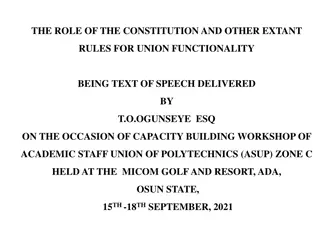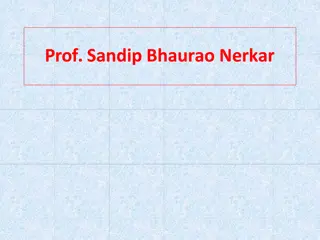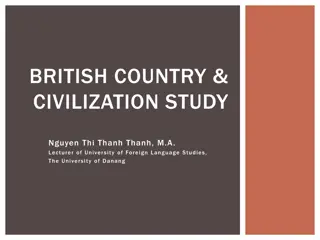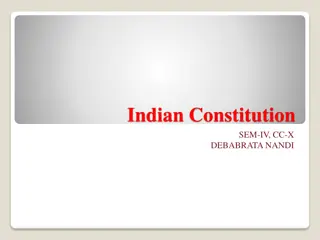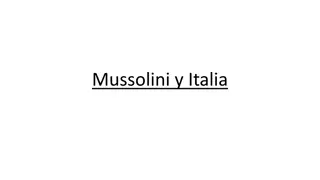Evolution of Limited Monarchy in English Constitution
The development of limited monarchy in the English Constitution is traced from Anglo-Saxon Britain through the introduction of feudalism. This system of governance established a complex relationship between the king, lords, and vassals, leading to the formation of the King's Council and the origins of Parliament. Feudalism shaped the authority structure and land tenure system, laying the foundation for the evolution of England's political institutions.
Download Presentation

Please find below an Image/Link to download the presentation.
The content on the website is provided AS IS for your information and personal use only. It may not be sold, licensed, or shared on other websites without obtaining consent from the author.If you encounter any issues during the download, it is possible that the publisher has removed the file from their server.
You are allowed to download the files provided on this website for personal or commercial use, subject to the condition that they are used lawfully. All files are the property of their respective owners.
The content on the website is provided AS IS for your information and personal use only. It may not be sold, licensed, or shared on other websites without obtaining consent from the author.
E N D
Presentation Transcript
The English Constitution: II -Origins and development of the Limited Monarchy Prof. Marco Olivetti October 11th, 2023
Anglo-Saxon Britain: a series of invasion of German and Danish tribes puts an end to Roman Britain during the IV century Division of the island in various regional Kingdoms A gradual process of unification, around military chiefs Saxon times and the turning point of 1066 A weak, elective, monarchy A Council, surrounding the King A very thin State, with a simple and essential administrative organization A turning point 1066 Norman Invasion A new monarchy and a new ruling class was introduced in England
Feudalism was introduced in England (or is modernized in more developed forms known in continental Europe) Feudalism was basically a system of land tenure by which the freeman held land from his lord in return for certain service military and other and the lord in his turn owed service to the king as overlord. But it was much more than a system of land tenure. Feudalism was a whole way of life a social system in which lord and vassal were bound together by the closest possible ties (MacKenzie, The English Parliament, p. 9) The Feudal origins of English monarchy Fragmentation of political authority Use of schemes of private law, based on the tenure of the land and on its transmission
Among the underlying ideas of feudalism there are three which stand out. - The first is that the king is the ultimate lord of all the land. - The second is that all land is held from an overlord in return for some service. - The third is that landholding carries with it certain authority over those living on the land. Feudalism Now these three ideas taken together may be summed up in the feudal principle that a man s rights and duties are determined by his particular relationship to land. Feudalism is a form of government depending upon land tenure . Except for the king at the top of the scale and the villein at the bottom, every man might be both lord and tenant. Thus the king may grant an estate to A who in turns grants part of it to B. And B may exact suit and service from C to whom he grants certain of his lands, and so on right down to villein Z who has no tenant (Prosser, Sharp, A Short Constitutional History of England, Longmans, London, 1938, p. 12)
The Kings Council right and duty of the barons to advice and support the King A Large and a Small Council: the forerunners of Parliament and Cabinet Traces of the origin of Parliament go back to Saxon times (before 1066, Norman Invasion) The Large Council: the Witana gemots (the Assembly of the barons in Saxon times) The feudal element in the Constitution Its function: consent to taxation, advising the King The King s vassals, alias tenants in chief, alias barons, as members of this feudal community, owed duty of attendance and advice in the royal court (McKenzie, p. 10) Royal Courts were held thrice a year. In the intervals between these great national assemblies, and for the ordinary business of government, the king relied upon a small number of personal advisers (familiares, domestici, ministri).
The King and the Barons were the basic elements of the feudal constitution ( the very essence of government in the XIII century) The rule was cooperation, but conflict was possible and actually took place Basic reasons of conflict: finance and respective obligations; relations between the King and the barons but also between the barons and the rest of the people Conflict and cooperation The barons tried to find ways to influence the policy of the King, of the Court and of the Royal administration Councils took place three times a year: the problem was how to influence and control the King in a stable way The provisions of Oxford (1258): a Council of 15 to remain at Court and to advice the King Other instruments: Charters and Parliaments
Various charters were adopted in the Medieval period in order to define the powers of the Estates of the realm, first of all of the King and of the barons Pacts between the King and the barons Some of these Charters were issued at the moment of coronation and were connected to the oath of the King: Charter of Liberties given by Henry I (1100) Charters of Stephen (1135 and 1136) Charter of Henry II (1154)
The most famous of these Charters is the Magna Charta Libertatum (or Great Charter of Liberties) of King John, 1215 The Whole of the Constitutional History of England is a commentary on this charter (Stubb, p. 291) A written Charter, a domination pact (Herrschaftsvertrag) but not a Constitution in the modern sense, with the aim of regulating the general organization of the State The Magna Charta Libertatum The political events that surrounded it and every clause of its Articles bear a feudal color (Jolliffe, p. 259) It includes heterogeneous provisions, mainly aiming at closing the conflict between the King and the Barons It does not grant rights but privileges, not to every persons, but to the Church, to barons, knights and free men Yet some provisions of the Charter are anticipatory of modern developments
The liberties of the Church of England (art. 1 & 63) Relation between the King and its barons in the possession and transmission of land (art. 2-9) Debts with Jews (art. 10-11) Scutage and aid (art. 12, 14 & 15) The city of London shall enjoy all its ancient liberties and free customs (art. 13) The Magna Charta Libertatum Various provisions on Justice (art. 17-24; 39; 45) Various provisions concerning goods, heritage and land (art. 25-37; 43-44, 47-48) Freedom from arrest (art. 39) Freedom of movement (art. 40-41) Specific provisions related to the previous war between the King and the Barons (art. 49-53; 55-60)
Art. 61 of the Charter If we, our chief justice, our officials, or any of our servants offend in any respect against any man, or transgress any of the articles of the peace or of this security The barons shall elect twenty-five of their number to keep, and cause to be observed with all their might, the peace and liberties granted and confirmed to them by this charter The Magna Charta Libertatum The barons are authorized to rebellion against the King until they have secured such redress as they have determined upon This is the diffidation followed by the lawful rebellion of feudalism (Jolliffe, p. 258), not a sort of Tribunal for the guarantee of the Charter
Parliament is the child of the occasional national assembly and retains today its essential character as an assembly representative of the nation The word appears in 1258: the Parliament who met in Oxford From 1258 it is possible to establish with more or less certainty the list of true parliaments they were summoned with a special writ, in order to distinguish them from other national assemblies The Initially only the barons were summoned, but already during the XIII century also representatives of the shires and later of the towns were called to participate to Parliament (1265 Simon de Monfort s Parliament) development of Parliament Two new elements in comparison with the Council: non-feudal elements and the idea of representation From a meeting to discuss to an organ of discussion: the Estates of the Realm Gradual formation of two Houses : House of Lords (nobility, high clergy) and House of Commons (from 1450)
Between the summon of the so called model Parliament (1295) and the middle of XV century, the structure and composition of Parliament remained uncertain It included a) The two archbishops and 18 bishops Composition and structure of Parliament b) The great secular nobility (dukes, marquesses, earls, viscounts, barons) on an equal foot ( Peers ) (hereditary; many were created anew by the King) the normal figure was about 50 c) The commons : two Squires for each county; two representatives for each city and each borough d) Representatives of the lower clergy
Individual summon and collective summon (representation) At the beginning the representatives were appointed, later elected ( franchise the privilege to vote) From 1450 it became a stable rule that the first two groups (Bishops and Peers) formed the House of Lords, the third the House of Commons, while the fourth (the lower clergy) had already ceased to participate to Parliament Composition and structure of Parliament Initially Parliament was a common meeting of Lords and Commons in the same place (the Parliament Chamber of the King s Palace): it was opened by the King and all discussion took place there From 1376 the Commons adopted the practice of retiring to a separate apartment to discuss and decide and then returned to the Parliament Chamber to give the result of their discussion through their Speaker
The rise of the House of Commons (XIV-XV century) as real voice of the nation: a) 1399 Deposition of Richard II and election of Henry IV as new King the King is based on a parliamentary title b) Parliamentary consent to taxation and to the appropriation of funds (for a specific purpose) becomes necessary: Parliaments affirms his right to control how money is acquired and spent c) Answering to petitions (for redressing of grievances) the answer to a petition becomes a law (statute) The Commons become Legislators (during the reigns of the three Edwards 1277- 1379): King and Parliament may create new law (statutes), superior to the law that the King may create without Parliament (ordinances) Main functions of Parliament d) Parliament tries to direct the general policy of the nation: - Selection of the Council by Parliament - Impeachment of ministers (and also Bills of attainder)
Procedure: how to vote a Motion, Yes and No, Division, Calculating the votes The Committees: Selected Committees, Committee of the Whole Organization of the House of Commons The Clerks and the Journals Elections territorial representation of counties and boroughs Until 1640 Parliament was not a permanent organ The King could interrupt its activity through adjournment and prorogation and could put an end to its existence through dissolution
The King ruled as well as reigned. he appointed and dismissed his own advisers and officials he could obstruct parliamentary legislation through veto and dissolution he could dispense the individual from the law he took part directly and personally in the initiation of all government activity (Coward, p. 81) The King While during the Lancasterian period (1399-1460) the position of the Monarch was weakened by the rise of the influence of Parliament, with the Tudor dynasty the King recovers fully the role of leader of the nation The concentration of powers in the monarchy after the war of the two roses: the Tudor Monarchy (1485-1603) strong King with strong Parliament
What was called later the executive power had its center, and also its arena for competing different views on the main areas of policy, in the King s Court. The King was assisted by one or two principal secretaries, with the task of coordinating his (small) central bureaucracy He was assisted by the Privy Council, a collective body of small size that developed in the XVI century from the royal council of medieval kings The King The members of the Privy Council were appointed by the King Gradually some subcommittee of the Privy Council were created with an autonomous role (one of them already in the XVII century was the Cabinet) Parliament tried to assert its influence on the Council and partially succeeded during the Lancasterian dynasty (1399- 1460)
The ideology justifying this position of the king the theory of the Divine Right of the Kings, according to which Kings were believed to God s lieutenants on earth James I (1603-1625) wrote a treatise exposing this argument Neither the Divine right, nor the position of the King as head of what today would be the Government and the central administration meant that they were considered as absolute . The Kings were supposed to be bound by the observation of the fundamental laws of the kingdom (a sort of un-written customary constitution) The King The King was obliged to rule not alone but with Parliament: parliamentary statute, adopted by the House of Commons, the House of Lords and the King was supposed to be superior to the King s act (ordinance). Taxation was supposed to be legitimate only with consent of Parliament. The medieval monarchy and the early modern monarchy (till XVI century) was a limited monarchy that had similar characters also in other European states.
W. STUBBS, Select Charters and other illustrations of English Constitutional history from the earliest times to the reign of Edward the first, IX ed., Clarendon Press, Oxford, 1921 C.W. PROSSER, M. SHARP, A Short Constitutional History of England, Longmans, Green and Co., London/New York/Toronto, 1938 J.E.A. JOLLIFFE, The Constitutional History of Medieval England, Van Nostrand, New York, 1937 Bibliography K. MACKENZIE, The English Parliament, Pelican, London, 1950 G.B. ADAMS, Constitutional history of England, Cape, London, 1921 M. FIORAVANTI, Appunti di storia delle Costituzioni moderne. I. Le libert : presupposti culturali e modelli storici, Giappichelli, Torino, 1991, p. 10-22



